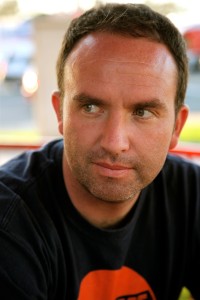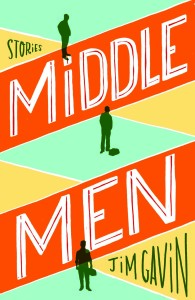When You’re Somewhere in the Middle: A Review of Jim Gavin’s “Middle Men”
BY CYNTHIA ROMANOWSKI
Nobody dreams about selling toilets when they grow up. It’s something that happens because something else didn’t happen—at least that’s what the young characters in Jim Gavin’s Middle Men might believe. Most of Gavin’s male protagonists are trying to do something, whether the goal is to get a basketball scholarship, find the girl that left, or just get a laugh or two at open mic night. Gavin’s characters are destined to come up short.
Author Jim Gavin / photo by Fred Schroeder
Like most of us, his characters are trying to move from the lives they have into the lives they want, but most of them get stuck somewhere in between. They are also painfully aware of their capacity to fail and quick to recognize themselves as the root cause of their misfortunes. In place of daydreams, Gavin’s men often fantasize about giving up:
“At times he craved the sweet tantalizing oblivion of giving up. His favorite word in the English language was ‘stick-to-itiveness,’ but the longer he hung around, the more he felt the enormity of his delusion.”
We encounter these men in various stages of resignation in an array of southern Californian cities. While there are two stories outside of the area (one is in Riverside and the other in San Francisco), Gavin is truly at his best when his characters appear in the lesser known cities of SoCal: Garden Grove, Anaheim, Carson, Boyle Heights, and Baldwin Park all make brief cameos.
The collection is made up of nine stories—most of which are much longer then the average story you’d find in a literary journal—but the stories don’t feel long. The characters are so human, (“Costello considers a burrito. It will destroy him, but what the hell”), and there are so many great one-liners, (“He hasn’t combed his hair on a Saturday in thirty years …”), and unexpected doses of humor scattered throughout, Gavin is able to avoid the melodrama and overt sentimentality that can often stifle longer stories in the realm of literary fiction.
His stories also move quickly because of the people in them; his characters feel real and completely relatable. Gavin’s protagonists include: an acne-faced high school basketball player, a production assistant who lets a finicky TV star walk all over him, a screenwriter who has lucked into a big break but is slowly going broke, and, in the last two stories of the collection, a father and son who hoof around the southland trying to sell toilets. Besides these leading men, Gavin also has a knack for crafting memorable secondary characters, an ability that all great short story writers seem to have in common.
When it comes to the SoCal setting, Gavin includes all the usual suspects: The sun, the endless freeways, the voice of Vin Scully, the haze. But he also has an impressive way of zeroing in on lesser known SoCal landmarks—the kind of things you don’t even realize are unique to the southland until he points them out: Disneyland fireworks on summer nights, the Panorama Lounge at the Long Beach Holiday Inn, endless bags of Del Taco, Orange County bros and their oversized trucks, a lunch table with a “gleaming metropolis of half-empty Tapatio bottles” upon it. All of these details create a vivid sense of place and capture the mood of this suburban landscape.
In fact, there are so many details related to life in the ‘burbs, Gavin’s readers are bound to reminisce.
“My mom called me inside and we ate Costco lasagna, a bottomless pit of goo that had lasted for three days.”
Gavin illustrates so many of these small yet familiar moments it’s hard not to remember your own versions of the things he describes: Feeling mortified in high school, letting yourself down, that ratty apartment filled with roommates, the crappy job that had you stuck on the freeway, the blatant idealism of your early 20s—it’s all in there.
There is also tenderness in these moments that can catch you off-guard; ordinary pieces of daily life are transformed:
“The house is dark and quiet. For a couple of hours, Costello sits at the dining room table, paying the bills. Still paying off the bust. Fifteen years without a vacation. Never taking her out to dinner, not once. A million Ragu dinners.”
The stories are linked thematically, and there is a gradual development throughout: Each protagonist is a little bit older and more established then the one in the story before. This development cumulates in the final story when we’re introduced to Marty Costello, a man who has gotten so used to struggling he’s actually found a way to be comfortable in the small life he’s made for himself. Here’s how his son, Matt, sees it:
“Matt used to wonder what his dad thought about as he drove the freeways all day, every day, and it made him sad to think that this man, who never complained about anything, might have dreamed about doing something else with his life besides selling toilets. But Matt realized now, with envy, that his father had moved beyond dreams. He belonged to this world, day after day.”
With this realization Gavin seems to be calling attention to a generational gap—what Matt’s generation may see as settling or giving up, his father’s generation sees as making ends meet. Unlike his son, Marty is not concerned with personal fulfillment or impressing anyone, he has found a way to raise a family and most importantly, he’s found a way to be content.
In the grind of daily life there are times when we might resolve to better ourselves or change our circumstances, but there is also comfort in the status quo. Likewise, there is a tremendous sense of relief when one finally learns to be content with the life he has. Just like the characters in Gavin’s Middle Men, most of us are trying reconcile who we are with who we’d like to become—the trick is finding contentment while you’re somewhere in the middle.


